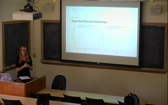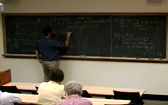Duncan Dauvergne : Geodesic networks in random geometry
- Presentations ( 30 Views )The directed landscape is a random directed metric on the plane that is the scaling limit for models in the KPZ universality class. In this metric, typical pairs of points are connected by a unique geodesic. However, certain exceptional pairs are connected by more exotic geodesic networks. The goal of this talk is to describe a full classification for these exceptional pairs. I will also discuss some connections with other models of random geometry.
Duncan Dauvergne : Random planar geometry and the Kardar-Parisi-Zhang universality class
- Presentations ( 35 Views )Consider the lattice Z^2, and assign length 1 or 2 to every edge by flipping a series of independent fair coins. This gives a random weighted graph, and looking at distances in this graph gives a random planar metric. This model is expected to have a continuum scaling limit as we decrease the spacing between lattice points. Moreover, most natural models of random planar metrics and random interface growth (the so-called `KPZ universality class') are expected to converge to the same limiting geometry. The goal of this talk is to introduce this limit, known as the directed landscape, and describe at least one model where we can actually prove convergence.
Jessica Fintzen : Frontiers in Mathematics Lecture 1: Representations of p-adic groups
- Presentations ( 275 Views )The Langlands program is a far-reaching collection of conjectures that relate different areas of mathematics including number theory and representation theory. A fundamental problem on the representation theory side of the Langlands program is the construction of all (irreducible, smooth, complex) representations of certain matrix groups, called p-adic groups. In my talk I will introduce p-adic groups and provide an overview of our understanding of their representations, with an emphasis on recent progress. I will also briefly discuss applications to other areas, e.g. to automorphic forms and the global Langlands program.
Florian Naef : A real description of brackets and cobrackets in string topology
- Presentations ( 269 Views )Let M be a manifold with non-vanishing vectorfield. The homology of the space of loops in M carries a natural Lie bialgebra structure described by Sullivan as string topology operations. If M is a surface, these operations where originally defined by Goldman and Turaev. We study formal descriptions of these Lie bialgebras. More precisely, for surfaces these Lie bialgebras are formal in the sense that they are isomorphic (after completion) to their algebraic analogues (Schedler's necklace Lie bialgebras) built from the homology of the surface. For higher dimensional manifolds we give a similar description that turns out to depend on the Chern-Simons partition function.
This talk is based on joint work with A. Alekseev, N. Kawazumi, Y. Kuno and T. Willwacher.
Sam Stechmann : Clouds, climate, and extreme precipitation events: Asymptotics and stochastic
- Presentations ( 281 Views )Clouds and precipitation are among the most challenging aspects of weather and climate prediction. Moreover, our mathematical and physical understanding of clouds is far behind our understanding of a "dry" atmospheric where water vapor is neglected. In this talk, in working toward overcoming these challenges, we present new results on clouds and precipitation from two perspectives: first, in terms of the partial differential equations (PDEs) for atmospheric fluid dynamics, and second, in terms of stochastic models. A new asymptotic limit will be described, and it leads to new PDEs for a precipitating version of the quasi-geostrophic equations, now including phase changes of water. Also, a new energy will be presented for an atmosphere with phase changes, and it provides a generalization of the quadratic energy of a "dry" atmosphere. Finally, it will be shown that the statistics of clouds and precipitation can be described by stochastic differential equations and stochastic PDEs. As one application, it will be shown that, under global warming, the most significant change in precipitation statistics is seen in the largest events -- which become even larger and more probable -- and the distribution of event sizes conforms to the stochastic models.
Joseph Rabinoff : From Diophantine equations to p-adic analytic geometry
- Presentations ( 235 Views )A Diophantine equation is a polynomial equation in several variables, generally with integer coefficients, like x3 + y3 = z3. Provably finding all integer solutions of a Diophantine equation is a storied mathematical problem that is easy to state and notoriously difficult to solve. The method of Chabauty--Coleman is one particularly successful technique for ruling out extraneous solutions of a certain class of Diophantine equations. The method is p-adic in nature, and involves producing p-adic analytic functions that vanish on all integer-valued solutions. I will discuss work with Katz and Zureick-Brown on finding uniform bounds on the number of rational points on a curve of fixed genus, defined over a number field, subject to a (conjecturally weak) restriction on its Jacobian. The same technique also makes progress on the uniform Manin-Mumford conjecture on the size of torsion packets on curves of fixed genus.
Kirsten Wickelgren : An arithmetic count of the lines on a cubic surface
- Presentations ( 280 Views )A celebrated 19th century result of Cayley and Salmon is that a smooth cubic surface over the complex numbers contains exactly 27 lines. By contrast, over the real numbers, the number of real lines depends on the surface. A classification was obtained by Segre, but it is a recent observation of Benedetti-Silhol, Finashin-Kharlamov, Horev-Solomon and Okonek-Teleman that a certain signed count of lines is always 3. We extend this count to an arbitrary field k using an Euler number in A1-homotopy theory. The resulting count is valued in the Grothendieck-Witt group of non-degenerate symmetric bilinear forms. (No knowledge of A1-homotopy theory will be assumed in the talk.) This is joint work with Jesse Kass.
Troy Schaudt : Mathematica 11 in Education and Research
- Presentations ( 274 Views )This technical talk will show live calculations in Mathematica 11 and other Wolfram technologies relevant to courses and research. Specific topics include: * Enter calculations in everyday English, or using the flexible Wolfram Language * Visualize data, functions, surfaces, and more in 2D or 3D * Store and share documents locally or in the Wolfram Cloud * Use the Predictive Interface to get suggestions for the next useful calculation or function options * Access trillions of bits of on-demand data * Use semantic import to enrich your data using Wolfram curated data * Easily turn static examples into mouse-driven, dynamic applications * Access 10,000 free course-ready applications * Utilize the Wolfram Language's wide scope of built-in functions, or create your own * Get deep support for specialized areas including machine learning, time series, image processing, parallelization, and control systems, with no add-ons required Current users will benefit from seeing the many improvements and new features of Mathematica 11 (https://www.wolfram.com/mathematica/new-in-11/), but prior knowledge of Mathematica is not required.
Steven Sam : Noetherianity in representation theory
- Presentations ( 223 Views )Abstract: Representation stability is an exciting new area that combines ideas from commutative algebra and representation theory. The meta-idea is to combine a sequence of objects together using some newly defined algebraic structure, and then to translate abstract properties about this structure to concrete properties about the original object of study. Finite generation is a particularly important property, which translates to the existence of bounds on algebraic invariants, or some predictable behavior. I'll discuss some examples coming from topology (configuration spaces) and algebraic geometry (secant varieties).
Eugenia Cheng : PLUM Lecture: How to Bake Pi, Making abstract mathematics palatable
- Presentations ( 251 Views )Mathematics can be tasty! Its a way of thinking, and not just about numbers. Through unexpectedly connected examples from music, juggling, and baking, I will show that math can be made fun and intriguing for all, through hands-on activities, examples that everyone can relate to, and funny stories. I'll present surprisingly high-level mathematics, including some advanced abstract algebra usually only seen by math majors and graduate students. There will be a distinct emphasis on edible examples.

 yes
yes












